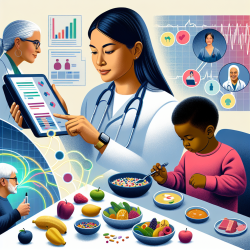Introduction
Food allergies are a significant concern, affecting the quality of life for children and their families. The recent research article, "Food allergy treatment value: Child caregiver and patient perspectives," provides valuable insights into how practitioners can enhance their skills and treatment strategies. By understanding the perspectives of both caregivers and patients, practitioners can make informed, data-driven decisions that improve outcomes for children with food allergies.
Understanding the Research
The study conducted by Abdelwadoud et al. utilized a modified Delphi technique to identify and prioritize treatment outcomes that are important to parents of children and adult patients with allergies to milk, egg, and peanut. The study's findings highlight the diverse challenges faced by these families, including social, psychological, medical, healthcare, financial, food selection, and awareness issues.
The research identified four key areas:
- Food allergy problems
- Treatment experiences
- Important treatment outcomes
- Value of different treatment options
These areas of consensus emphasize the shared priority for reducing the risk of potentially fatal allergic reactions and the need for reliable treatments. The study underscores the hope for a permanent cure and the fear of serious allergic reactions as the most valued treatment options.
Implementing Research Outcomes in Practice
Practitioners can leverage these insights to enhance their therapeutic approaches. Here are some strategies:
- Personalized Treatment Plans: Develop individualized treatment plans that address the specific needs and concerns of each child and their family.
- Comprehensive Education: Provide thorough education to families about managing food allergies, including recognizing symptoms and understanding treatment options.
- Collaborative Care: Work closely with other healthcare providers to ensure a multidisciplinary approach to treatment, which can improve overall outcomes.
- Focus on Quality of Life: Consider the psychological and social impacts of food allergies on children and their families, and integrate support services into treatment plans.
Encouraging Further Research
While the study provides valuable insights, there is always room for further research. Practitioners are encouraged to explore additional areas such as:
- The long-term effectiveness of various treatment options
- Innovative therapies that may offer permanent solutions
- The impact of food allergies on different demographics and socioeconomic groups
By engaging in continuous research and staying informed about the latest developments, practitioners can ensure they are providing the best possible care to their patients.
Conclusion
Incorporating the findings from the "Food allergy treatment value: Child caregiver and patient perspectives" study into practice can significantly improve outcomes for children with food allergies. By focusing on personalized care, comprehensive education, collaborative approaches, and quality of life, practitioners can make a meaningful difference in the lives of their patients and their families.
To read the original research paper, please follow this link: Food allergy treatment value: Child caregiver and patient perspectives.










